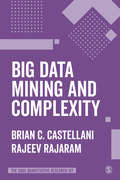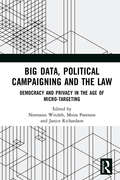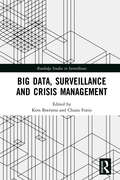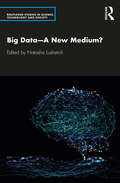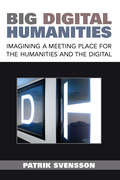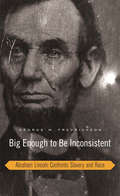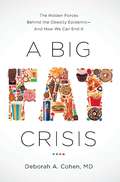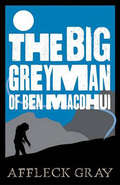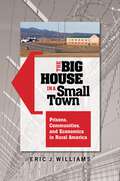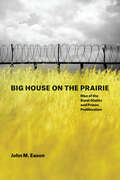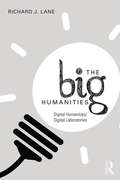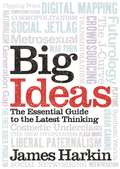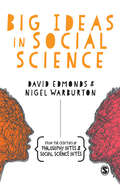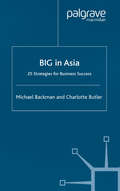- Table View
- List View
Big Data Mining and Complexity (The SAGE Quantitative Research Kit)
by Brian C. Castellani Rajeev RajaramThis book offers a much needed critical introduction to data mining and ‘big data’. Supported by multiple case studies and examples, the authors provide: Digestible overviews of key terms and concepts relevant to using social media data in quantitative research. A critical review of data mining and ‘big data’ from a complexity science perspective, including its future potential and limitations A practical exploration of the challenges of putting together and managing a ‘big data’ database An evaluation of the core mathematical and conceptual frameworks, grounded in a case-based computational modeling perspective, which form the foundations of all data mining techniques Part of The SAGE Quantitative Research Kit, this book will give you the know-how and confidence needed to succeed on your quantitative research journey.
Big Data, Political Campaigning and the Law: Democracy and Privacy in the Age of Micro-Targeting
by Janice Richardson Moira Paterson Normann WitzlebIn this multidisciplinary book, experts from around the globe examine how data-driven political campaigning works, what challenges it poses for personal privacy and democracy, and how emerging practices should be regulated. The rise of big data analytics in the political process has triggered official investigations in many countries around the world, and become the subject of broad and intense debate. Political parties increasingly rely on data analytics to profile the electorate and to target specific voter groups with individualised messages based on their demographic attributes. Political micro-targeting has become a major factor in modern campaigning, because of its potential to influence opinions, to mobilise supporters and to get out votes. The book explores the legal, philosophical and political dimensions of big data analytics in the electoral process. It demonstrates that the unregulated use of big personal data for political purposes not only infringes voters’ privacy rights, but also has the potential to jeopardise the future of the democratic process, and proposes reforms to address the key regulatory and ethical questions arising from the mining, use and storage of massive amounts of voter data. Providing an interdisciplinary assessment of the use and regulation of big data in the political process, this book will appeal to scholars from law, political science, political philosophy and media studies, policy makers and anyone who cares about democracy in the age of data-driven political campaigning.
Big Data, Political Campaigning and the Law: Democracy and Privacy in the Age of Micro-Targeting
by Janice Richardson Moira Paterson Normann WitzlebIn this multidisciplinary book, experts from around the globe examine how data-driven political campaigning works, what challenges it poses for personal privacy and democracy, and how emerging practices should be regulated. The rise of big data analytics in the political process has triggered official investigations in many countries around the world, and become the subject of broad and intense debate. Political parties increasingly rely on data analytics to profile the electorate and to target specific voter groups with individualised messages based on their demographic attributes. Political micro-targeting has become a major factor in modern campaigning, because of its potential to influence opinions, to mobilise supporters and to get out votes. The book explores the legal, philosophical and political dimensions of big data analytics in the electoral process. It demonstrates that the unregulated use of big personal data for political purposes not only infringes voters’ privacy rights, but also has the potential to jeopardise the future of the democratic process, and proposes reforms to address the key regulatory and ethical questions arising from the mining, use and storage of massive amounts of voter data. Providing an interdisciplinary assessment of the use and regulation of big data in the political process, this book will appeal to scholars from law, political science, political philosophy and media studies, policy makers and anyone who cares about democracy in the age of data-driven political campaigning.
Big Data, Surveillance and Crisis Management (Routledge Studies in Surveillance)
by Kees Boersma Chiara FonioBig data, surveillance, crisis management. Three largely different and richly researched fields, however, the interplay amongst these three domains is rarely addressed. Through unique international case studies this book examines the links between these three fields. Considering crisis management as an 'umbrella term' that covers a number of crises and ways of managing them, this book explores the collection of ‘big data’ by governmental crisis organisations, as well as the unintended consequences of using such data. In particular, through the lens of surveillance, the contributions investigate how the use and abuse of big data can easily lead to monitoring and controlling the behaviour of people affected by crises. Readers will understand that big data in crisis management must be examined as a political process, involving questions of power and transparency. A highly topical volume, Big Data, Surveillance and Crisis Management will appeal to postgraduate students and postdoctoral researchers interested in fields including Sociology and Surveillance Studies, Disaster and Crisis Management, Media Studies, Governmentality, Organisation Theory and Information Society Studies.
Big Data, Surveillance and Crisis Management (Routledge Studies in Surveillance)
by Kees Boersma and Chiara FonioBig data, surveillance, crisis management. Three largely different and richly researched fields, however, the interplay amongst these three domains is rarely addressed. Through unique international case studies this book examines the links between these three fields. Considering crisis management as an 'umbrella term' that covers a number of crises and ways of managing them, this book explores the collection of ‘big data’ by governmental crisis organisations, as well as the unintended consequences of using such data. In particular, through the lens of surveillance, the contributions investigate how the use and abuse of big data can easily lead to monitoring and controlling the behaviour of people affected by crises. Readers will understand that big data in crisis management must be examined as a political process, involving questions of power and transparency. A highly topical volume, Big Data, Surveillance and Crisis Management will appeal to postgraduate students and postdoctoral researchers interested in fields including Sociology and Surveillance Studies, Disaster and Crisis Management, Media Studies, Governmentality, Organisation Theory and Information Society Studies.
Big Data—A New Medium? (Routledge Studies in Science, Technology and Society)
by Natasha LushetichDrawing on a range of methods from across science and technology studies, digital humanities and digital arts, this book presents a comprehensive view of the big data phenomenon. Big data architectures are increasingly transforming political questions into technical management by determining classificatory systems in the social, educational, and healthcare realms. Data, and their multiple arborisations, have become new epistemic landscapes. They have also become new existential terrains. The fundamental question is: can big data be seen as a new medium in the way photography or film were when they first appeared? No new medium is ever truly new. It’s always remediation of older media. What is new is the medium’s re-articulation of the difference between here and there, before and after, yours and mine, knowable and unknowable, possible and impossible. This transdisciplinary volume, incorporating cultural and media theory, art, philosophy, history, and political philosophy is a key resource for readers interested in digital humanities, cultural, and media studies.
Big Data—A New Medium? (Routledge Studies in Science, Technology and Society)
by Natasha LushetichDrawing on a range of methods from across science and technology studies, digital humanities and digital arts, this book presents a comprehensive view of the big data phenomenon. Big data architectures are increasingly transforming political questions into technical management by determining classificatory systems in the social, educational, and healthcare realms. Data, and their multiple arborisations, have become new epistemic landscapes. They have also become new existential terrains. The fundamental question is: can big data be seen as a new medium in the way photography or film were when they first appeared? No new medium is ever truly new. It’s always remediation of older media. What is new is the medium’s re-articulation of the difference between here and there, before and after, yours and mine, knowable and unknowable, possible and impossible. This transdisciplinary volume, incorporating cultural and media theory, art, philosophy, history, and political philosophy is a key resource for readers interested in digital humanities, cultural, and media studies.
Big Digital Humanities: Imagining a Meeting Place for the Humanities and the Digital (Digital Humanities)
by Patrik SvenssonBig Digital Humanities has its origins in a series of seminal articles Patrik Svensson published in the Digital Humanities Quarterly between 2009 and 2012. As these articles were coming out, enthusiasm around Digital Humanities was acquiring a great deal of momentum and significant disagreement about what did or didn’t “count” as Digital Humanities work. Svensson’s articles provided a widely sought after omnibus of Digital Humanities history, practice, and theory. They were informative and knowledgeable and tended to foreground reportage and explanation rather than utopianism or territorial contentiousness. In revising his original work for book publication, Svensson has responded to both subsequent feedback and new developments. Svensson’s own unique perspective and special stake in the Digital Humanities conversation comes from his role as director of the HUMlab at Umeå University. HUMlab is a unique collaborative space and Digital Humanities center, which officially opened its doors in 2000. According to its own official description, the HUMlab is an open, creative studio environment where “students, researchers, artists, entrepreneurs and international guests come together to engage in dialogue, experiment with technology, take on challenges and move scholarship forward.” It is this last element “moving scholarship forward” that Svensson argues is the real opportunity in what he terms the “big digital humanities,” or digital humanities as practiced in collaborative spaces like the HUMlab, and he is uniquely positioned to take an account of this evolving dimension of Digital Humanities practice.
Big Enough to Be Inconsistent: Abraham Lincoln Confronts Slavery and Race (The W. E. B. Du Bois Lectures)
by George M. Fredrickson“Cruel, merciful; peace-loving, a fighter; despising Negroes and letting them fight and vote; protecting slavery and freeing slaves.” Abraham Lincoln was, W. E. B. Du Bois declared, “big enough to be inconsistent.” Big enough, indeed, for every generation to have its own Lincoln—unifier or emancipator, egalitarian or racist. In an effort to reconcile these views, and to offer a more complex and nuanced account of a figure so central to American history, this book focuses on the most controversial aspect of Lincoln’s thought and politics—his attitudes and actions regarding slavery and race. Drawing attention to the limitations of Lincoln’s judgment and policies without denying his magnitude, the book provides the most comprehensive and even-handed account available of Lincoln’s contradictory treatment of black Americans in matters of slavery in the South and basic civil rights in the North. George Fredrickson shows how Lincoln’s antislavery convictions, however genuine and strong, were held in check by an equally strong commitment to the rights of the states and the limitations of federal power. He explores how Lincoln’s beliefs about racial equality in civil rights, stirred and strengthened by the African American contribution to the northern war effort, were countered by his conservative constitutional philosophy, which left this matter to the states. The Lincoln who emerges from these pages is far more comprehensible and credible in his inconsistencies, and in the abiding beliefs and evolving principles from which they arose. Deeply principled but nonetheless flawed, all-too-human yet undeniably heroic, he is a Lincoln for all generations.
A Big Fat Crisis: The Hidden Forces Behind the Obesity Epidemic - and How We Can End It
by Deborah CohenObesity is the public health crisis of the twenty-first century. Over 150 million Americans are overweight or obese, and across the globe an estimated 1.5 billion are affected. In A Big Fat Crisis, Dr. Deborah A. Cohen has created a major new work that will transform the conversation surrounding the modern weight crisis. Based on her own extensive research, as well as the latest insights from behavioral economics and cognitive science, Cohen reveals what drives the obesity epidemic and how we, as a nation, can overcome it.Cohen argues that the massive increase in obesity is the product of two forces. One is the immutable aspect of human nature, namely the fundamental limits of self-control and the unconscious ways we are hard-wired to eat. And second is the completely transformed modern food environment, including lower prices, larger portion sizes, and the outsized influence of food advertising. We live in a food swamp, where food is cheap, ubiquitous, and insidiously marketed. This, rather than the much-discussed "food deserts," is the source of the epidemic.The conventional wisdom is that overeating is the expression of individual weakness and a lack of self-control. But that would mean that people in this country had more willpower thirty years ago, when the rate of obesity was half of what it is today! The truth is that our capacity for self-control has not shrunk; instead, the changing conditions of our modern world have pushed our limits to such an extent that more and more of us are simply no longer up to the challenge.Ending this public health crisis will require solutions that transcend the advice found in diet books. Simply urging people to eat less sugar, salt, and fat has not worked. A Big Fat Crisis offers concrete recommendations and sweeping policy changes-including implementing smart and effective regulations and constructing a more balanced food environment-that represent nothing less than a blueprint for defeating the obesity epidemic once and for all.
A Big Fat Crisis: The Hidden Forces Behind the Obesity Epidemic - and How We Can End It
by Deborah CohenObesity is the public health crisis of the twenty-first century. Over 150 million Americans are overweight or obese, and across the globe an estimated 1.5 billion are affected. In A Big Fat Crisis, Dr. Deborah A. Cohen has created a major new work that will transform the conversation surrounding the modern weight crisis. Based on her own extensive research, as well as the latest insights from behavioral economics and cognitive science, Cohen reveals what drives the obesity epidemic and how we, as a nation, can overcome it. Cohen argues that the massive increase in obesity is the product of two forces. One is the immutable aspect of human nature, namely the fundamental limits of self-control and the unconscious ways we are hard-wired to eat. And second is the completely transformed modern food environment, including lower prices, larger portion sizes, and the outsized influence of food advertising. We live in a food swamp, where food is cheap, ubiquitous, and insidiously marketed. This, rather than the much-discussed "food deserts," is the source of the epidemic. The conventional wisdom is that overeating is the expression of individual weakness and a lack of self-control. But that would mean that people in this country had more willpower thirty years ago, when the rate of obesity was half of what it is today! The truth is that our capacity for self-control has not shrunk; instead, the changing conditions of our modern world have pushed our limits to such an extent that more and more of us are simply no longer up to the challenge. Ending this public health crisis will require solutions that transcend the advice found in diet books. Simply urging people to eat less sugar, salt, and fat has not worked. A Big Fat Crisis offers concrete recommendations and sweeping policy changes-including implementing smart and effective regulations and constructing a more balanced food environment-that represent nothing less than a blueprint for defeating the obesity epidemic once and for all.
The Big Grey Man of Ben Macdhui
by Affleck GrayIn an acclaimed account of the terrifying figure said to haunt the desolate passes and summit of Britain's second highest mountain, this book takes on one of Scotland's most chilling unsolved mysteries. Throughout the years, countless climbers have either seen or sensed the presence of some extraordinary being in the misty wilderness of Ben MacDhui. This book explores the evidence and also looks at similar stories from around the world to try and make sense of this bizarre phenomenon.
The Big House in a Small Town: Prisons, Communities, and Economics in Rural America
by Eric J. WilliamsThis work is an in-depth, on-the-ground examination of how prisons impact rural communities, including a revealing study of two rural communities that have chosen prisons as an economic development strategy.A recent study by the Urban Institute estimates that one-third of all counties in the United States house a prison, and that our prison and jail population is now over 2.1 million. Another report indicates that more than 97 percent of all U.S. prisoners are eventually released, and communities are absorbing nearly 650,000 formerly incarcerated individuals each year. These figures are particularly alarming considering the fact that rural communities are using prisons as economic development vehicles without fully understanding the effects of these jails on the area.This book is the result of author Eric J. Williams' ground-level research about the effects of prisons upon two rural American communities that lobbied to host maximum security prisons. Through hundreds of interviews conducted while living in Florence, Colorado, and Beeville, Texas, Williams offers the perspective of local residents on all sides of the issue, as well as a social history told mainly from the standpoint of those who lobbied for the prisons.
Big House on the Prairie: Rise of the Rural Ghetto and Prison Proliferation
by John M. EasonFor the past fifty years, America has been extraordinarily busy building prisons. Since 1970 we have tripled the total number of facilities, adding more than 1,200 new prisons to the landscape. This building boom has taken place across the country but is largely concentrated in rural southern towns. In 2007, John M. Eason moved his family to Forrest City, Arkansas, in search of answers to key questions about this trend: Why is America building so many prisons? Why now? And why in rural areas? Eason quickly learned that rural demand for prisons is complicated. Towns like Forrest City choose to build prisons not simply in hopes of landing jobs or economic wellbeing, but also to protect and improve their reputations. For some rural leaders, fostering a prison in their town is a means of achieving order in a rapidly changing world. Taking us into the decision-making meetings and tracking the impact of prisons on economic development, poverty, and race, Eason demonstrates how groups of elite whites and black leaders share power. Situating prisons within dynamic shifts that rural economies are undergoing and showing how racially diverse communities lobby for prison construction, Big House on the Prairie is a remarkable glimpse into the ways a prison economy takes shape and operates.
Big House on the Prairie: Rise of the Rural Ghetto and Prison Proliferation
by John M. EasonFor the past fifty years, America has been extraordinarily busy building prisons. Since 1970 we have tripled the total number of facilities, adding more than 1,200 new prisons to the landscape. This building boom has taken place across the country but is largely concentrated in rural southern towns. In 2007, John M. Eason moved his family to Forrest City, Arkansas, in search of answers to key questions about this trend: Why is America building so many prisons? Why now? And why in rural areas? Eason quickly learned that rural demand for prisons is complicated. Towns like Forrest City choose to build prisons not simply in hopes of landing jobs or economic wellbeing, but also to protect and improve their reputations. For some rural leaders, fostering a prison in their town is a means of achieving order in a rapidly changing world. Taking us into the decision-making meetings and tracking the impact of prisons on economic development, poverty, and race, Eason demonstrates how groups of elite whites and black leaders share power. Situating prisons within dynamic shifts that rural economies are undergoing and showing how racially diverse communities lobby for prison construction, Big House on the Prairie is a remarkable glimpse into the ways a prison economy takes shape and operates.
Big House on the Prairie: Rise of the Rural Ghetto and Prison Proliferation
by John M. EasonFor the past fifty years, America has been extraordinarily busy building prisons. Since 1970 we have tripled the total number of facilities, adding more than 1,200 new prisons to the landscape. This building boom has taken place across the country but is largely concentrated in rural southern towns. In 2007, John M. Eason moved his family to Forrest City, Arkansas, in search of answers to key questions about this trend: Why is America building so many prisons? Why now? And why in rural areas? Eason quickly learned that rural demand for prisons is complicated. Towns like Forrest City choose to build prisons not simply in hopes of landing jobs or economic wellbeing, but also to protect and improve their reputations. For some rural leaders, fostering a prison in their town is a means of achieving order in a rapidly changing world. Taking us into the decision-making meetings and tracking the impact of prisons on economic development, poverty, and race, Eason demonstrates how groups of elite whites and black leaders share power. Situating prisons within dynamic shifts that rural economies are undergoing and showing how racially diverse communities lobby for prison construction, Big House on the Prairie is a remarkable glimpse into the ways a prison economy takes shape and operates.
Big House on the Prairie: Rise of the Rural Ghetto and Prison Proliferation
by John M. EasonFor the past fifty years, America has been extraordinarily busy building prisons. Since 1970 we have tripled the total number of facilities, adding more than 1,200 new prisons to the landscape. This building boom has taken place across the country but is largely concentrated in rural southern towns. In 2007, John M. Eason moved his family to Forrest City, Arkansas, in search of answers to key questions about this trend: Why is America building so many prisons? Why now? And why in rural areas? Eason quickly learned that rural demand for prisons is complicated. Towns like Forrest City choose to build prisons not simply in hopes of landing jobs or economic wellbeing, but also to protect and improve their reputations. For some rural leaders, fostering a prison in their town is a means of achieving order in a rapidly changing world. Taking us into the decision-making meetings and tracking the impact of prisons on economic development, poverty, and race, Eason demonstrates how groups of elite whites and black leaders share power. Situating prisons within dynamic shifts that rural economies are undergoing and showing how racially diverse communities lobby for prison construction, Big House on the Prairie is a remarkable glimpse into the ways a prison economy takes shape and operates.
Big House on the Prairie: Rise of the Rural Ghetto and Prison Proliferation
by John M. EasonFor the past fifty years, America has been extraordinarily busy building prisons. Since 1970 we have tripled the total number of facilities, adding more than 1,200 new prisons to the landscape. This building boom has taken place across the country but is largely concentrated in rural southern towns. In 2007, John M. Eason moved his family to Forrest City, Arkansas, in search of answers to key questions about this trend: Why is America building so many prisons? Why now? And why in rural areas? Eason quickly learned that rural demand for prisons is complicated. Towns like Forrest City choose to build prisons not simply in hopes of landing jobs or economic wellbeing, but also to protect and improve their reputations. For some rural leaders, fostering a prison in their town is a means of achieving order in a rapidly changing world. Taking us into the decision-making meetings and tracking the impact of prisons on economic development, poverty, and race, Eason demonstrates how groups of elite whites and black leaders share power. Situating prisons within dynamic shifts that rural economies are undergoing and showing how racially diverse communities lobby for prison construction, Big House on the Prairie is a remarkable glimpse into the ways a prison economy takes shape and operates.
Big House on the Prairie: Rise of the Rural Ghetto and Prison Proliferation
by John M. EasonFor the past fifty years, America has been extraordinarily busy building prisons. Since 1970 we have tripled the total number of facilities, adding more than 1,200 new prisons to the landscape. This building boom has taken place across the country but is largely concentrated in rural southern towns. In 2007, John M. Eason moved his family to Forrest City, Arkansas, in search of answers to key questions about this trend: Why is America building so many prisons? Why now? And why in rural areas? Eason quickly learned that rural demand for prisons is complicated. Towns like Forrest City choose to build prisons not simply in hopes of landing jobs or economic wellbeing, but also to protect and improve their reputations. For some rural leaders, fostering a prison in their town is a means of achieving order in a rapidly changing world. Taking us into the decision-making meetings and tracking the impact of prisons on economic development, poverty, and race, Eason demonstrates how groups of elite whites and black leaders share power. Situating prisons within dynamic shifts that rural economies are undergoing and showing how racially diverse communities lobby for prison construction, Big House on the Prairie is a remarkable glimpse into the ways a prison economy takes shape and operates.
The Big Humanities: Digital Humanities/Digital Laboratories
by Richard J. LaneThis book provides an accessible introduction to, and overview of, the digital humanities, one of the fastest growing areas of literary studies. Lane takes a unique approach by focusing on the technologies and the new environment in which the digital humanities largely takes place: the digital laboratory. The book provides a brief history of DH, explores and explains the methodologies of past and current DH projects, and offers resources such as detailed case studies and bibliographies. Further, the focus on the digital laboratory space reveals affiliations with the types of research that have traditionally taken place in the sciences, as well as convergences with other fast-growing research spaces, namely innovation labs, fabrication labs, maker spaces, digital media labs, and change labs. The volume highlights the profound transformation of literary studies that is underway, one in which the adoption of powerful technology – and concomitantly being situated within a laboratory environment – is leading to an important re-engagement in the arts and humanities, and a renewed understanding of literary studies in the digital age, as well as a return to large-scale financial investment in humanistic research. It will be useful to students and teachers, as well as administrators and managers in charge of research infrastructure and funding decisions who need an accessible overview of this technological transformation in the humanities. Combining useful detail and an overview of the field, the book will offers accessible entry into this rapidly growing field.
The Big Humanities: Digital Humanities/Digital Laboratories
by Richard J. LaneThis book provides an accessible introduction to, and overview of, the digital humanities, one of the fastest growing areas of literary studies. Lane takes a unique approach by focusing on the technologies and the new environment in which the digital humanities largely takes place: the digital laboratory. The book provides a brief history of DH, explores and explains the methodologies of past and current DH projects, and offers resources such as detailed case studies and bibliographies. Further, the focus on the digital laboratory space reveals affiliations with the types of research that have traditionally taken place in the sciences, as well as convergences with other fast-growing research spaces, namely innovation labs, fabrication labs, maker spaces, digital media labs, and change labs. The volume highlights the profound transformation of literary studies that is underway, one in which the adoption of powerful technology – and concomitantly being situated within a laboratory environment – is leading to an important re-engagement in the arts and humanities, and a renewed understanding of literary studies in the digital age, as well as a return to large-scale financial investment in humanistic research. It will be useful to students and teachers, as well as administrators and managers in charge of research infrastructure and funding decisions who need an accessible overview of this technological transformation in the humanities. Combining useful detail and an overview of the field, the book will offers accessible entry into this rapidly growing field.
Big Ideas: The Essential Guide to the Latest Thinking
by James HarkinA witty and indispensable guide to modern-day buzzwords.Big Ideas explains where concepts like 'the long tail', 'urban tribes' and 'soft power' came from, what they mean, and what their critics say about them. It includes explanations of key terms such as: Maturialism: the name given to the new trend among middle-aged people of spending their money on expensive 'youth' gadgets and services, and the new habit among advertisers of targeting the mid-life market, repositioning their brands as accessories to the distinctive joys of mid-life. The Tipping Point: the controversial idea that the best way to understand everything from changing fashions to the rise of teenage smoking is to imagine people as viruses and social phenomena as contagious epidemics. Social Jet Lag: an ailment suffered by up to half the population, social jet lag is said to arise when our body clocks falls out of synch with the demands of our environments, thus putting us at risk of chronic fatigue and an increased susceptibility to disease.
Big Ideas in Social Science
by David Edmonds Nigel WarburtonAre human beings less violent than before? Why do we adopt certain moral and political judgements? Why is the gap between rich and poor getting bigger? How do we decide which criminal policies are effective? What is the Population Challenge for the 21st Century? What is social science? In Big Ideas in Social Science, David Edmonds and Nigel Warburton put these and more of our society’s burning questions to 18 of the world’s leading social scientists including Steven Pinker, Ann Oakley, Lawrence Sherman, Kate Pickett, Robert J. Shiller and Doreen Massey. The result is a collection of thought-provoking discussions that span the fields of sociology, politics, economics, criminology, geography and many more.From the people who brought us the Philosophy Bites series, Big Ideas in Social Science is a fascinating and accessible introduction to the key ideas and findings of the social sciences. The interviews for this book are based on a series of podcasts, Social Science Bites, sponsored by SAGE. Social Science Bites was inspired by the popular Philosophy Bites podcast (www.philosophybites.com), which was founded by David and Nigel in 2007 and has so far had 26 million downloads. Philosophy Bites has spawned three books, Philosophy Bites, Philosophy Bites Back and Philosophy Bites Again.
Big Ideas in Social Science (PDF)
by David Edmonds Nigel WarburtonAre human beings less violent than before? Why do we adopt certain moral and political judgements? Why is the gap between rich and poor getting bigger? How do we decide which criminal policies are effective? What is the Population Challenge for the 21st Century? What is social science? In Big Ideas in Social Science, David Edmonds and Nigel Warburton put these and more of our society’s burning questions to 18 of the world’s leading social scientists including Steven Pinker, Ann Oakley, Lawrence Sherman, Kate Pickett, Robert J. Shiller and Doreen Massey. The result is a collection of thought-provoking discussions that span the fields of sociology, politics, economics, criminology, geography and many more.From the people who brought us the Philosophy Bites series, Big Ideas in Social Science is a fascinating and accessible introduction to the key ideas and findings of the social sciences. The interviews for this book are based on a series of podcasts, Social Science Bites, sponsored by SAGE. Social Science Bites was inspired by the popular Philosophy Bites podcast (www.philosophybites.com), which was founded by David and Nigel in 2007 and has so far had 26 million downloads. Philosophy Bites has spawned three books, Philosophy Bites, Philosophy Bites Back and Philosophy Bites Again.
Big in Asia: 25 Strategies for Business Success
by M. Backman C. ButlerCompanies operating in post-crisis Asia find themselves confronted by obstacles that hinder development and progress. Written by two leading analysts, this book identifies the transformation of the competitive landscape in Asia. By focusing on the main difficulties faced by companies it provides a series of strategies for business success and show how to avoid failure in Asia. This is an essential guide for companies who wish to make it big in Asia.
